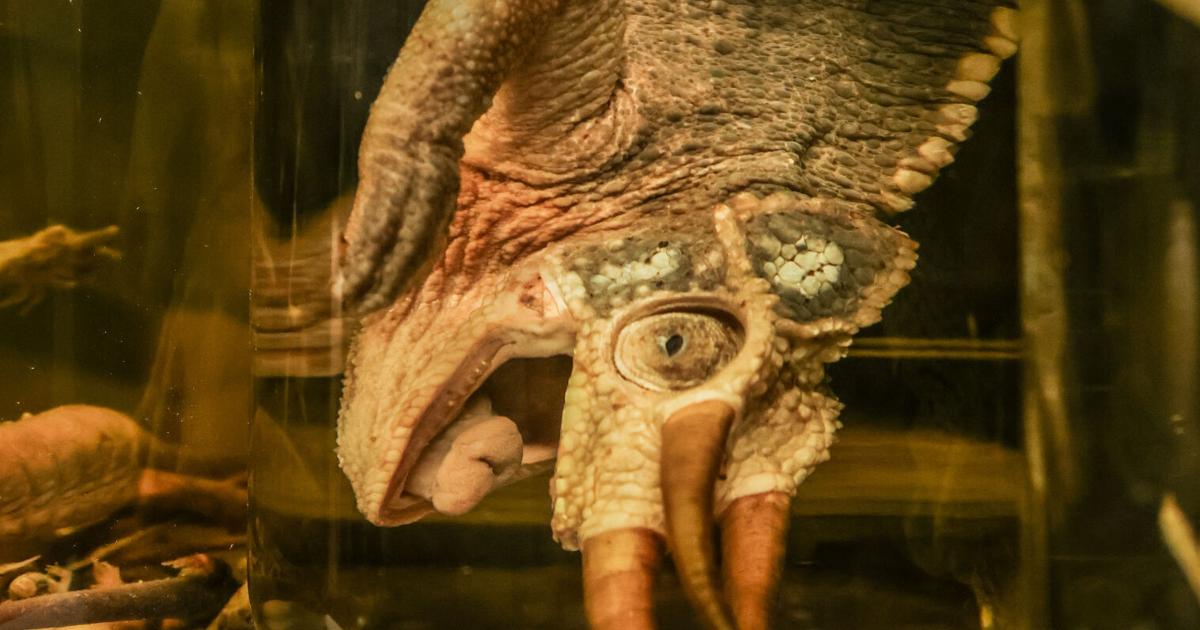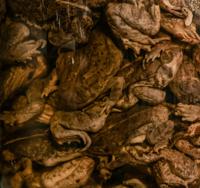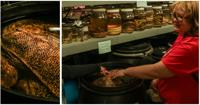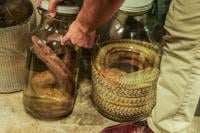A preserved horned chameleon sits in a jar during the Night at the Museum event Oct. 21 at the Amphibian and Reptile Diversity Research Center. Around 35 attendees came to learn about herpetology.
Preserved amphibians and reptiles sloshed around in jars as students and community members picked them up Tuesday at the Amphibian and Reptile Diversity Research Center at the Night at the Museum event.
Students and attendees moved around the space, pointing at and trying to identify different species preserved in jars of ethanol as Gregory Pandelis, collections manager and biology curator, led them on a tour of the center.
Lamar High School students Allyssa Austell, right, and Emma Kokisch look at preserved specimens during the Night at the Museum event Oct. 21 at the Amphibian and Reptile Diversity Research Center. Gregory Pandelis, collections manager and biology curator, visited Lamar to talk to students about herpetology.
Pandelis said once a semester, the museum typically hosts an event through the Herpetology Club to showcase its work.
“People don’t normally get to see it, but we really like to engage with our students in that way, to kind of show them that ‘hey, this is a really cool thing we have here and it’s really important,’” he said.
Gregory Pandelis, collections manager and biology curator, talks to attendees during the Night at the Museum event Oct. 21 at the Amphibian and Reptile Diversity Research Center. The museum typically hosts an event through the Herpetology Club once a semester.
Around 35 attendees squeezed into the prep lab, careful not to knock over jars, some dating back hundreds of years.
The room housed a freezer with tens of thousands of vials containing tissue and livers with preserved DNA from amphibians and reptiles, Pandelis said. He said researchers can sequence the DNA and other types of genetic material.
“It is a dead frog in a jar, but it also has a whole lot of data that goes with it,” Pandelis said. “Data that tells us exactly where it’s from, maybe what day it was found, what year, maybe even what it was doing when it was located.”
Preserved frog specimens sit in a jar during the Night at the Museum event Oct. 21 at the Amphibian and Reptile Diversity Research Center. The species are preserved in jars of ethanol.
In the amphibian and reptile range, attendees ran their fingers down the scaly back of a Komodo dragon in a preservation barrel, one of many tactile specimens available for closer inspection. In the same barrel lies another Komodo dragon and a crocodile.
“Being able to actually feel their texture and their skin is really cool,” said art education junior Maclain Lemoine.
Art education junior Maclain Lemoine touches a preserved Komodo dragon during the Night at the Museum event Oct. 21 at the Amphibian and Reptile Diversity Research Center. Lemoine said she enjoyed looking at the animals up close.
During the tour, attendees had the chance to learn about the Cenaspis aenigma, a new species of snake discovered partially digested in the stomach of a coral snake.
“They went back to the area where the coral snake was from for basically 50 years, looking for another one, and they never found one,” he said. “That’s the only one to this day that we have.”
Gregory Pandelis, collections manager and biology curator, shows students an amphiuma, a type of salamander, and a king cobra during the Night at the Museum event Oct. 21 at the Amphibian and Reptile Diversity Research Center. Pandelis described the amphiuma as an almost legless salamander because of its small legs.
A preserved Cenaspis aenigma snake is shown in a jar during the Night at the Museum event Oct. 21 at the Amphibian and Reptile Diversity Research Center. It is a new species of snake discovered partially digested in the stomach of a coral snake.
Tarrant County College students Grey Williams and Alexandra Koog said they came to the event due to their shared interest in bugs and reptiles.
“We’re both just kind of nerds,” Koog said.
Pandelis said he hoped to get across to attendees that biodiversity and research museums are the fundamental source of knowledge of life on Earth.
“This is really how we know everything we know about animals and plants and everything else, is through research specimens like this,” he said.
An attendee looks at jars of specimens during the Night at the Museum event Oct. 21 at the Amphibian and Reptile Diversity Research Center. There are two rooms containing hundreds of specimens of amphibians and reptiles.
@tay._.sansom @pixaperfect_
photo-editor.shorthorn@uta.edu








